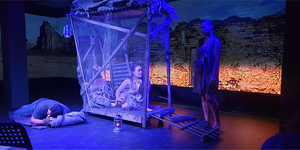 Recorded video reviewed by Barry Lenny, Sunday 3rd April 2022.
Recorded video reviewed by Barry Lenny, Sunday 3rd April 2022.
Dr, Corinna Di Niro, who gained her doctorate in Commedia dell'arte, has turned her attention to the topic of Domestic Family Violence. For her company, Stage Secrets, she has adapted and directed the late Geoff Gillham's play for Theatre-In-Education (TIE),
Bone Cage, which appears in his book, Six Plays for Theatre in Education and Youth Theatre. She has included a range of modern technology to increase its impact on the audience. It was presented to audiences in two ways, a live performance in the Hartley Playhouse, and streamed to watch at home. Rated MA15+, a question and answer session followed the performance.
Quoting the publicity, for simplicity and accuracy, "Corinna Di Niro runs an independent theatre company, Stage Secrets, and is a lecturer/creative researcher at the University of South Australia. She is passionate about using theatre as a tool for social change, in particular, raising awareness of issues affecting women and children. Her adaptation of 'Bone Cage' pushes the boundaries of theatre by integrating immersive technology - a concept stemming from her VR+Theatre TEDx talk in 2019. In conjunction with fellow UniSA creatives, Corinna and her team of local artists demonstrate the power of theatre in this heart-wrenching and tragically beautiful piece that confronts the very real and often conflicting challenges of women trying to leave abusive relationships."
Before the work begins, the audience is given a QR code that can be used to download an app, to be able to interact with the Q&A session after the performance.
It opens at a bar, where two women, workmates, are having a drink. Scenes of the bar are projected onto screens behind them. The husband of one of the women arrives, and is introduced to the other woman. We are seeing the faces that the pair displays to the outside world, that of a loving couple. His interruption to their conversation, removing his wife's drink from her hand, and immediately leaving with her, seems innocuous enough at the time. He is, though, exerting his control over her.
Throughout, the soundscape, lighting, projections, and even the costuming, are very important, adding other aspects to the work.
In the next scene, he wheels in a squeaking and creaking structure, the bone cage, a thing of timber beams, chicken wire mesh, iron railings, chains, and locks. She is tethered to it by a rope around her neck. The projected backdrop is now a derelict building, symbolically representing the home as it has become to her. He subjects her to a tirade of mental abuse, controlling every aspect of her existence. She also shows signs of physical abuse. He monitors her telephone messages. The cage, of course, is inside her head, built and maintained by her husband, and from which she can see no means of escape, such is the strength of his ongoing campaign to demoralise and silence her. She has lost all hope of escape. Dialogue is minimal, and the long silences add to the tension. He falls asleep, snoring.
Night passes and, out of the darkness, videos of violence are projected, giving way to the same derelict building. A second woman appears, offering support, freedom, and happiness, questioning her as to why she remains, and suggesting escape. It could be an internal conversation, a discussion with herself, and one that she has probably had a hundred times. She tries to dismiss the whole idea.
He states, from his subconscious, his belief that he is the master of his little domain, in total control, to be obeyed without question, and with the right to punish transgressions. His bullying is terrible. Her internal conflict is heartrending. She wants to leave, but has plenty of excuses for staying, in spite of what staying means for her. She feels that leaving could be worse than staying. She has been brainwashed, conditioned by him. One might suggest that it is a variation of Stockholm Syndrome.
Snatches of text had appeared in the spaces between scenes, and it now fades to a wall of text, phrases from the play. Will she leave, will she stay? It is an open-ended finish to the play, and leads into the Q&A session.
There is a large team of people assisting Dr. Di Niro with this complex production, contributing to each of the aspects, technical, and artistic. They are Susannah Emery and Claudia Kuerschner, audience interactivity, Andrei Gostin, film and lighting, Dr. Phil van Hout, soundscape, Gina Matezki, immersive video and sound, and Jonathan Kovarch, digital media and photography. Of paramount importance, of course, are the superb performances of Robert Donnarumma, the husband, Georgia Laity, the wife, and Suzanne Bleeze.
The immediacy, the immersion that would have been felt by the audience in the venue is, naturally, largely lost in watching a video, but it is still a powerful performance. This is an important piece of work that goes far beyond being a theatrical production and, no doubt, will be performed on many more occasions in the future.
Photography, Jonathan Kovarch
Comments
To post a comment, you must
register and
login.
 Recorded video reviewed by Barry Lenny, Sunday 3rd April 2022.
Recorded video reviewed by Barry Lenny, Sunday 3rd April 2022..png)
.png)

